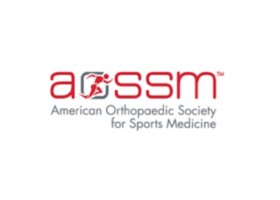
Authors:
Marco-Christopher Rupp, Annabel R Geissbuhler, Joan C Rutledge, Marilee P Horan, Phob Ganokroj, Peter Chang, Matthew T Provencher, Peter J Millett
Abstract:
Background:
Anterior instability of the sternoclavicular joint (SCJ) is a rare but potentially devastating pathological condition, particularly when it occurs in young or active patients. SCJ reconstruction using hamstring tendon autograft is a commonly used treatment option, yet to date results are limited to small case series. Studies on baseline, preoperative factors and their association with postoperative outcome are limited.
Purpose:
To assess the midterm clinical outcomes and survivorship after SCJ reconstruction using hamstring tendon autograft in patients experiencing anterior SCJ instability and to determine whether baseline patient or causative factors are associated with postoperative outcomes or patient satisfaction.
Study design:
Case series; Level of evidence, 4.
Methods:
Patients who underwent SCJ reconstruction with a hamstring tendon autograft for anterior SCJ instability between October 2005 and October 2020 were included in this retrospective single-center study. At a minimum of 2 years postoperatively, clinical outcomes were collected, including the following patient-reported outcomes (PROs): the 12-Item Short Form Survey (SF-12) score; American Shoulder and Elbow Surgeons (ASES) score; Quick Disabilities of the Arm, Shoulder and Hand (QuickDASH) score; Single Assessment Numeric Evaluation (SANE) score; and visual analog scale (VAS) pain score. Subjective postoperative satisfaction with the procedure was quantified on a scale from 0 (very unsatisfied) to 10 (very satisfied). The predictive role of patient factors, including age, sex, and injury in dominant arm, on postoperative PROs and satisfaction at short-term follow-up was evaluated using multiple linear regression.
Results:
A total of 49 patients (mean age, 29.6 ± 16.2 years; range 13.8-67.1 years; 27 females) were included in the final analysis. At a mean follow-up of 3.9 ± 2.1 years, all PROs had significantly improved, including the mean SF-12 Physical Component Summary score (40.4 ± 6.8 to 52.6 ± 6.9; P < .001), ASES score (54.9 ± 20.4 to 91.0 ± 11.3; P < .001), QuickDASH score (41.2 ± 18.5 to 10.2 ± 9.1; P < .001); SANE score (50.2 ± 21.1 to 88.3 ± 8.8; P < .001), VAS pain score (4.4 ± 2.6 to 0.8 ± 1.4; P < .001), and VAS pain score at its worst (7.4 ± 2.5 to 3.3 ± 2.6; P < .001). The median postoperative satisfaction score was 9 (range, 1-10). Revision-free survivorship was 95.9%. Male patients had a significantly lower VAS pain score at its worst compared with female patients (2.6 ± 2.6 vs 4.1 ± 2.4; P = .045); higher age was significantly correlated with a worse QuickDASH score (correlation coefficient, 0.314; P = .036). Overhead athletes had a significantly lower propensity to return to sport compared with nonoverhead athletes (P = .043), with only 45% of the overhead athletes returning to a level similar to their preinjury level, whereas 81% of the nonoverhead athletes were able to do so.
Conclusion:
The significant improvements in clinical and sport-specific outcomes and high patient satisfaction after SCJ reconstruction with a hamstring tendon autograft demonstrate the success of this procedure in treating anterior SCJ instability. Male sex and younger patient age are associated with superior outcomes, while overhead athletes have to be counseled about difficulties of returning to preinjury level of sport postoperatively.
You may request the complete study: Predictors of Clinical Outcomes and Quality of Life After Sternoclavicular Joint Reconstruction With Hamstring Tendon Autograft
